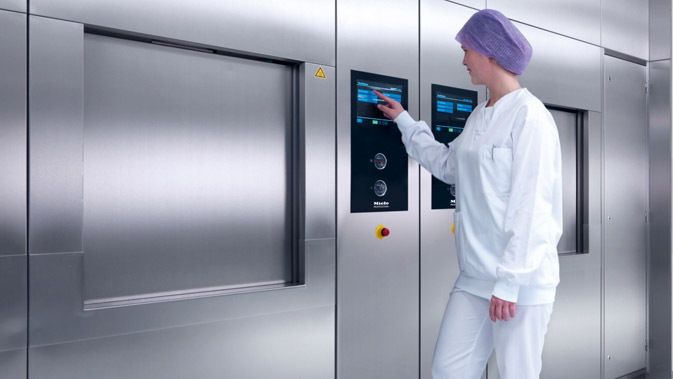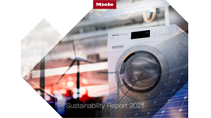Press releases
Miele Professional: Photo-electric sensor monitors saturated steam in all sterilisation processes

Large steam sterilisers offer even greater margin of safety
Miele Professional is set to present new highlights on its large steam sterilisers due for launch in May 2017 at Medica 2016. Miele's 4D sensor, a device which monitors the effectiveness of the steam sterilisation process better than any other system available, is likely to attract particular attention.
Steam sterilisation represents the most frequently used method to sterilise medical products. According to the EN ISO 17665-1 and EN 285 standards, a prerequisite for effective sterilisation is the presence of saturated steam. Alongside temperature, pressure and time, saturated steam is one of the elementary conditions for the successful deactivation of bacteria in the sterilisation process.
On its new sterilisers, Miele Professional is now presenting a system which detects the presence of saturated steam in all sterilisation processes, giving users the peace of mind of knowing that safe sterilisation has taken place.
In the case of the 4D Sensor, the presence of saturated steam is detected with the aid of a special photo-electric sensor. 'Only saturated steam absorbs light to the necessary degree, allowing the sensor to report that this key sterilisation parameter has been met. If saturated steam does not reach the sensor, the system issues an error message and the programme is aborted', explains Michael Sedlag, Head of Medical Technology at Miele Professional.
Miele refers to this technology as 'adding the fourth dimension to instrument reprocessing' as the 4D sensor reliably and precisely monitors the preconditions for the safe sterilisation with saturated steam, meaningfully complementing the other three dimensions of pressure, temperature and time.
New sensors for maximum safety in compliance with EN 285 standard
In order for steam to be of a requisite quality for the sterilisation process, it must not only be saturated but also free from non-condensable gases (NCG). This requirement is enshrined in the EN 285 standard. On the latest generation of products, Miele Professional offers an NCG sensor which detects these gases in condensate. Using a high-precision weighing cell, this device detects the presence of gases through minute weight differences which indicate that condensate is lighter and hence contains non-condensable gases. NCGs jeopardise sterilisation and hence users are warned by an alert in the machine display.
The sterilisation process can also be impaired by air leakages which can also be reliably detected on Miele sterilisers using an optional Air Detector. Its key component is a spirally wound, narrow-lumened tube connected to the chamber discharge pipe and equipped with temperature sensors at both ends. The latter concurrently measure the temperature of the condensate at the ends of the tube. A difference between the two readings of more than 2K indicates air leakages and automatically terminates the sterilisation programme.
Automatic descaling of vacuum pump
One of the most important prerequisites in achieving successful sterilisation is the evacuation of all air from the chamber. A deep vacuum is provided by a powerful water ring pump in which the impeller is sealed by a ring of water. Depending on the quality of the supply water, limescale deposits may build up over time on the vanes of the impeller which would seriously impair its functioning and may even reach the stage at which replacement becomes necessary. With the new automatic descaling function, Miele Professional has come up with an effective remedy: Very small quantities of phosphoric acid are added to the feed water supply to bind limescale and prevent it from depositing on impellers. This way, the need for maintenance is seriously reduced up to a water hardness of 20°dH (German hardness scale), thereby significantly extending the life expectancy of the vacuum pump. This saves customers the additional cost of pre-treating water, repairs and maintenance and expensive machine downtimes.
The new large steam sterilisers will, as previously, be available in four model series. The special design of the chamber with its fully heated jacket guarantees the extremely uniform distribution of heat. 'With these special features ranging from the 4D sensor to automatic vacuum pump descaling, Miele Professional is setting new standards in the field of sterilisation' says medical technology expert Michael Sedlag. 'The new models are particularly safe, innovative and economical to run'.
(707 words, 4,623 characters incl. spaces)
Company profile: Miele is the world's leading manufacturer of premium domestic appliances including cooking, baking and steam-cooking appliances, refrigeration products, coffee makers, dishwashers and laundry and floor care products. This line-up is augmented by dishwashers, washer-extractors and tumble dryers for commercial use as well as washer-disinfectors and sterilisers for use in medical and laboratory applications (Miele Professional). The Miele company, founded in 1899, has 8 production plants in Germany as well as one plant each in Austria, the Czech Republic, China and Romania. 2015/16 turnover amounted to approx. EUR 3.71 bn with sales outside Germany accounting for around 70%. Miele is represented with its own sales subsidiaries and via importers in almost 100 countries. The Miele company, now in the fourth generation of family ownership, employs a workforce of around 18,400, 10,300 thereof in Germany. The company headquarters are located in Gütersloh/Westphalia, Germany.
Download as PDF Download incl. media (zip)
Anke Schläger
+ 49 5241 89-1949
anke.schlaeger@miele.com
Media information
| Description | Download |
|---|---|

The safe destruction of micro-organisms in a large steam steriliser from Miele Professional is guaranteed by new highlight features on Miele products due to be launched in May 2017. |
High Resolution TIFF |
| High Resolution JPG | |

Identifies the presence of non-condensable gases in condensate: The NCG sensor from Miele Professional registers even the minutest of variations in the weight of condensate. For this purpose, the condensate is passed through high-precision weighing cells via the tubing illustrated. An error message in the display warns users in the event that condensate is lighter than specified. |
High Resolution TIFF |
| High Resolution JPG | |

Even greater safety is offered by the optional Air Detector. Its key component is a spirally wound narrow-lumened tube (centre) connected to the chamber discharge pipe and equipped with temperature sensors at both ends. These simultaneously measure the temperature of the condensate in the tube. If the discrepancy exceeds the permissible level, the sterilisation programme is automatically aborted. |
High Resolution TIFF |
| High Resolution JPG |


